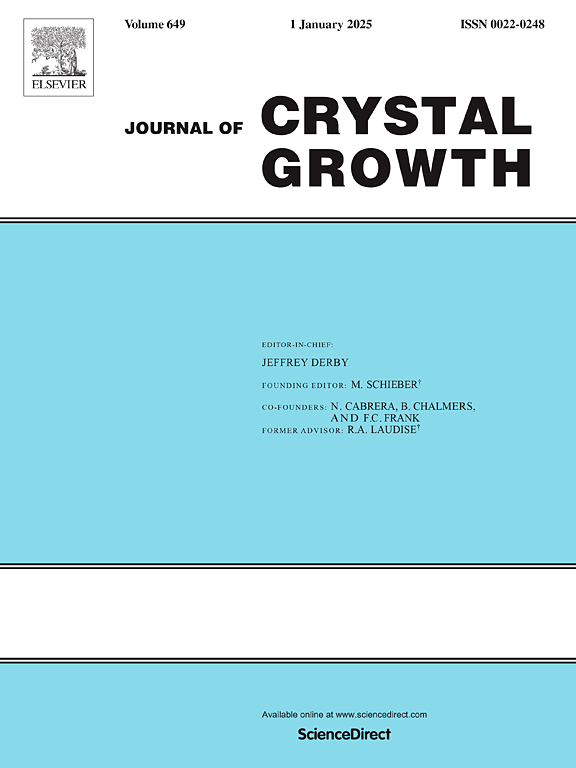Surface mound formation and growth via step destabilization under a direct current electric field on (001) strontium titanate single crystals
IF 1.7
4区 材料科学
Q3 CRYSTALLOGRAPHY
引用次数: 0
Abstract
The specific heat-treatment conditions are crucial for facilitating surface-diffusion processes that lead to the reconstruction of surface structures in oxide single crystals. This reconstruction gives rise to a step-terrace structure, which is characterized by steps with heights equivalent to the unit cell and atomically flat terraces. A method using a power spike (i.e., a flash event) generated under an applied electric field above the threshold value has emerged as a promising approach for promoting such surface reconstruction. In this study, we performed Scanning Electron Microscopy (SEM) and Atomic Force Microscopy (AFM) to examine the (001) surface structure of a strontium titanate single crystal treated with a flash event induced by a Direct Current (DC) electric field. We observed the formation of a step-terrace structure on the (001) surface even with a short holding time of 1 min under the flash event (initial voltage of 300 V/cm at a limiting current of 35 mA). However, a surface mound with a height of approximately 5.5 nm also formed on the surface, the height of which increased with holding time. SEM and AFM observations of the same surface location revealed that the formation of the surface mound is due to the formation of anti-bands as well as the bunching of surface steps, which is caused by their destabilization under the DC electric field. To avoid the formation of surface mounds, we suggest using an alternating electric field to trigger the flash event, which does not destabilize the steps.
(001)钛酸锶单晶在直流电场下通过阶进失稳形成和生长
特定的热处理条件对于促进表面扩散过程至关重要,从而导致氧化单晶表面结构的重建。这种重建产生了阶梯阶地结构,其特点是台阶的高度相当于单元格和原子平坦的露台。利用在高于阈值的外加电场下产生的功率尖峰(即闪光事件)的方法已经成为促进这种表面重建的有希望的方法。在这项研究中,我们使用扫描电子显微镜(SEM)和原子力显微镜(AFM)来研究经直流(DC)电场诱导的闪光事件处理的钛酸锶单晶的(001)表面结构。我们观察到(001)表面在闪光事件(初始电压为300 V/cm,极限电流为35 mA)下,即使保持时间很短(1分钟),也能形成阶梯状结构。然而,表面也形成了一个高度约为5.5 nm的表面丘,其高度随着保温时间的延长而增加。同一表面位置的SEM和AFM观测表明,表面丘的形成是由于反带的形成和表面台阶的聚集,这是由于它们在直流电场下不稳定造成的。为了避免形成表面土丘,我们建议使用交变电场来触发闪光事件,这不会使台阶不稳定。
本文章由计算机程序翻译,如有差异,请以英文原文为准。
求助全文
约1分钟内获得全文
求助全文
来源期刊

Journal of Crystal Growth
化学-晶体学
CiteScore
3.60
自引率
11.10%
发文量
373
审稿时长
65 days
期刊介绍:
The journal offers a common reference and publication source for workers engaged in research on the experimental and theoretical aspects of crystal growth and its applications, e.g. in devices. Experimental and theoretical contributions are published in the following fields: theory of nucleation and growth, molecular kinetics and transport phenomena, crystallization in viscous media such as polymers and glasses; crystal growth of metals, minerals, semiconductors, superconductors, magnetics, inorganic, organic and biological substances in bulk or as thin films; molecular beam epitaxy, chemical vapor deposition, growth of III-V and II-VI and other semiconductors; characterization of single crystals by physical and chemical methods; apparatus, instrumentation and techniques for crystal growth, and purification methods; multilayer heterostructures and their characterisation with an emphasis on crystal growth and epitaxial aspects of electronic materials. A special feature of the journal is the periodic inclusion of proceedings of symposia and conferences on relevant aspects of crystal growth.
 求助内容:
求助内容: 应助结果提醒方式:
应助结果提醒方式:


